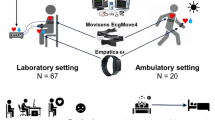Abstract
Since the dawn of the industrial era, modern devices and interaction methods have undergone rigorous evaluations in order to ensure their functionality and quality, as well as usability. While there are many methods for measuring objective data, capturing and interpreting subjective factors—like the feelings or states of mind of the users—is still an imprecise and usually post-event process. In this paper we propose the utilization of the Emotiv EPOC commercial electroencephalographic (EEG) neuroheadset for real-time support during evaluations and user studies. We show in two evaluation scenarios that the wireless EPOC headsets can be used efficiently for supporting subjectivity measurement. Additionally, we highlight situations that may result in a lower accuracy, as well as explore possible reasons and propose solutions for improving the error rates of the device.



Similar content being viewed by others
References
Benbadis SR, Rielo D (2011) EEG artifacts. In: Medscape reference. http://emedicine.medscape.com/article/1140247-overview. Accessed July 2011
Calhoun GL, McMillan GR (1996) EEG-based control for human-computer interaction. In: Proc of the third annual symposium on human interaction with complex systems (HICS’96), pp 4–9
Campbell A, Choudhury T, Hu S, Lu H, Mukerjee MK, Rabbi M, Raizada RDS (2010) NeuroPhone: brain-mobile phone interface using a wireless EEG headset. In: Proc of MobiHeld 2010. ACM, New York, pp 3–8
Cernea D, Olech PS, Ebert A, Kerren A (2011) EEG-based measurement of subjective parameters in evaluations. In: Proc of the 14th international conference on human-computer interaction (HCII), Orlando, Florida, USA, pp 279–283
Grimes D, Tan DS, Hudson SE, Shenoy P, Rao RPN (2008) Feasibility and pragmatics of classifying working memory load with an electroencephalograph. In: Proc of CHI 2008. ACM, New York, pp 835–844
Horlings R, Datcu D, Rothkrantz LJM (2008) Emotion recognition using brain activitiy. In: Proc of CompSysTech. ACM, New York, article 6
Jung TP, Makeig S, Humphries C, Lee TW, McKeown MJ, Iragui V, Sejnowski TJ (2000) Removing electroencephalographic artifacts by blind source separation. Psychophysiology 37(2):163–178
Leeb R, Friedmann D, Mueller-Putz GR, Scherer R, Slater M, Pfurtscheller G (2007) Self-paced (asynchronous) BCI control of a wheelchair in virtual environments: a case study with a tetraplegic. Intell Neurosci 1–12
Li X, Hu B, Zhu T, Yan J, Zheng F (2009) Towards affective learning with an EEG feedback approach. In: Proceedings of the first ACM international workshop on multimedia technologies for distance learning (MTDL’09), pp 33–38
Mikhail M, El-Ayat K, El Kaliouby R, Coan J, Allen JJB (2010) Emotion detection using noisy EEG data. In: Proc of AH 2010. ACM, New York, pp 1–7
Ranky GN, Adamovich S (2010) Analysis of a commercial EEG device to control a robot arm. In: Proc of the 2010 IEEE 36th annual northeast, pp 1–2
Ruffini G, Dunnea S, Fuentemillab L, Graub C, Farres E, Marco-Pallares J, Watts PCP, Silva SRP (2008) First human trials of a dry electrophysiology sensor using a carbon nanotube array interface. Sens Actuators 144:275–279
Scherer R, Mueller GR, Neuper C, Graimann B, Pfurtscheller G (2004) An asynchronously controlled EEG-based virtual keyboard: improvement of the spelling rate. IEEE Trans Biomed Eng 51(6):979–984
Swartz BE, Goldensohn ES (1998) Timeline of the history of EEG and associated fields. Electroencephalogr Clin Neurophysiol 106(2):173–176
Van De Velde M, Van Erp G, Cluitmans PJM (1998) Detection of muscle artefact in the normal human awake EEG. Electroencephalogr Clin Neurophysiol 107(2):149–158
Yuksel BF, Donnerer M, Tompkin J, Steed A (2010) A novel brain-computer interface using a multi-touch surface. In: Proc of the 28th international conference on human factors in computing systems (CHI’10), pp 855–858
EmSense. emsense.com
NeuroSky. http://www.neurosky.com
Acknowledgements
This work was supported by the German Research Foundation (DFG, grant number 1131) as part of the International Graduate School (IRTG) in Kaiserslautern on Visualization of Large and Unstructured Data Sets.
Author information
Authors and Affiliations
Corresponding author
Rights and permissions
About this article
Cite this article
Cernea, D., Olech, PS., Ebert, A. et al. Measuring Subjectivity. Künstl Intell 26, 177–182 (2012). https://doi.org/10.1007/s13218-011-0165-0
Published:
Issue Date:
DOI: https://doi.org/10.1007/s13218-011-0165-0




